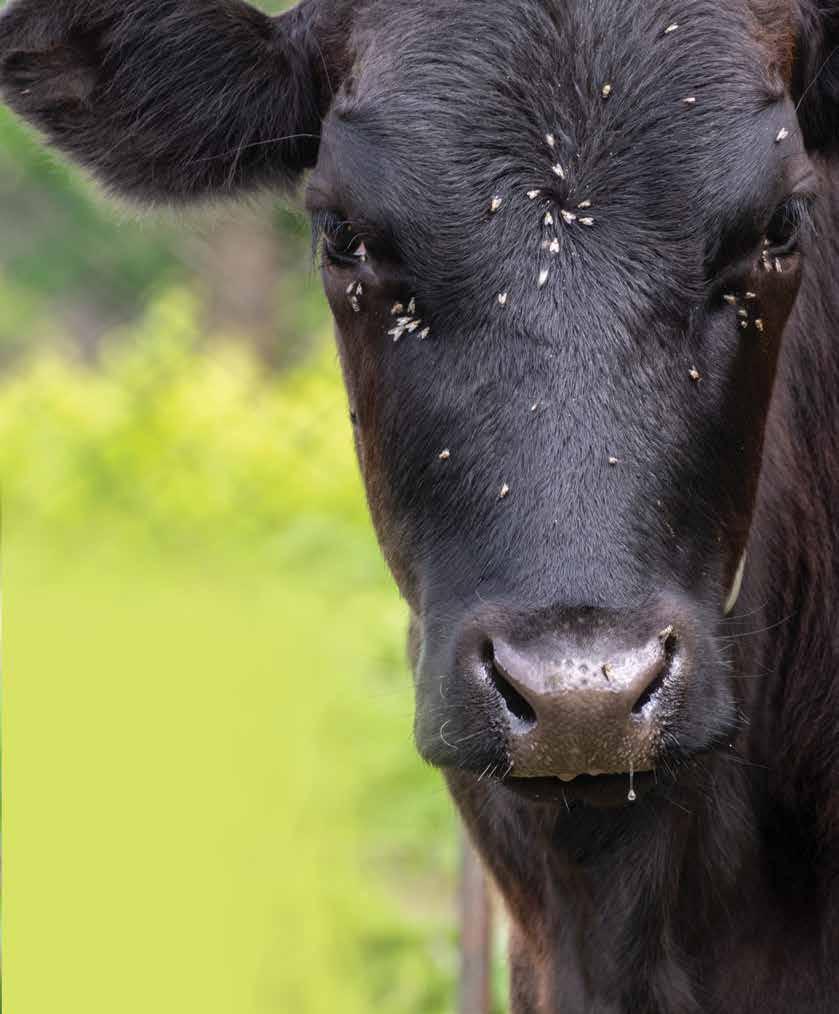
3 minute read
Business of Farming
The Economic Importance of Pests on Cattle
Ken Kelley, Kelly Palmer and Max Runge
Advertisement
The importance of controlling pests on livestock can be easily observed by anyone on any given day in any (untreated) cattle pasture in Alabama. There are pests all around, both observable and unseen, doing what they do best to cattle – pestering them. Tails flick and cattle move about restlessly as literally hundreds of flies congregate on them. The most unobservant observer would see that the annoyance factor alone dictates something must be done. However, it goes beyond simply annoying – pests on livestock (cattle in this example) can be detrimental to production of cattle and to the economic viability of many producers‘ operations.
So, horn flies can cause economic damage to cattle. With extreme ly high infestations, it is very reasonable to expect significant weight losses on feeder cattle in Alabama, with conceivable weight loss for feeders in the 50 pound range. Fifty pounds of calf at $1.30 per pound is $65 per calf, easily more than enough to justi fy the cost of the tags and the cost of putting them in.
While there are many different types of pests to consider, for our conversation today we will talk about the flies mentioned earlier. In fact, we will get even more specific – we will talk horn flies. Horn flies (Haematobia irritans) are the most economically important external parasites of cattle in the United States, causing millions of dollars in losses annually. The flies feed on cattle by piercing the hide and sucking blood. Fighting the flies drains the cattle’s energy and interferes with feeding and resting. USDA leaflet 388 “Horn Flies on Cattle” states losses can be as much as ½ pound per day and 20% milk reduction. That is significant! Research has shown (Byford et al., 1999) that heavy horn fly infestations caused animals to spend significantly more time standing, lying and resting, and significantly less time grazing and drinking. In other words, they were constantly being harassed and therefore not eating, drinking and growing. The same research shows significant physiological markers correlated to heavy fly control. The research demonstrated as populations of flies increased, so did heart rate, respiration and urine output, while water intake and nitrogen retained decreased.
So, horn flies can cause economic damage to cattle. With extremely high infestations, it is very reasonable to expect significant weight losses on feeder cattle in Alabama, with conceivable weight loss for feeders in the 50 pound range. Fifty pounds of calf at $1.30 per pound is $65 per calf, easily more than enough to justify the cost of the tags and the cost of putting them in. Will every calf cost that amount? Certainly not! Will some cost that? Certainly so! We can very reliably assume, though, based on research, that the majority of herds in Alabama will benefit from horn fly control.

There are numerous options for horn fly control in Alabama, with some much more effective than others. Dusters, backrubs, sprays and impregnated tags can all be effective for fly control in given situations. Effectiveness of these options is often determined by (1) efficacy of the chemical used for treatment and (2) efficacy of the delivery mechanism. There are downsides and hiccups associated with all the delivery methodologies – dusters get gummy in the southern humidity, rubbers must be recharged, and cattle have to be caught and handled to apply the tags. There is also a great deal of issue with some of the chemistries available, with resistance a major issue in some of the older chemistries. Resistance is the reason why many of the sprays that were once effective no longer seem to give very long control.
So, what do you use? The answer is (and this isn’t just an economist’s cop-out), it depends! Some important questions to ponder … What did you use last year? And the year before that? Can you catch your animal? Is your herd isolated from other herds? Your answers to these questions will help determine the right strategy for your cattle. Alabama Cooperative Extension System agents are currently conducting efficacy trials to help producers make these decisions easier in the future. In the meantime, reach out to your local animal science agent, we can help you figure out the best solution for your cattle. Whatever you do this summer … do something … with the already tight margins, controlling flies is an investment that will result in higher returns for your cattle operation.










